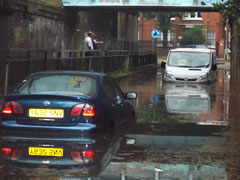Flash floods bring chaos to Chiswick
Environmental catastrophe as raw sewage pumped into Thames
Many roads and streets in Chiswick flooded this Tuesday as a violent thunderstorm was accompanied by an exceptionally heavy fall of rain. Estimates are that up to 1.5 inches of rain fell in a half hour period a level that would normally be high for the whole of the month of July in London.
The storm overwhelmed the existing water infrastructure and Thames Water was forced to pump untreated sewage into the Thames before it was forced onto residential streets through manhole covers. This has caused the deaths of tens of thousands of fish causing destruction to the local Thames eco-system that will take years to repair.
The storm hit West London worst of all with reports of massive hailstones hitting Hammersmith reminiscent of a scene in the recently released film on global warming, 'The Day After Tomorrow.' In Hyde Park 3 teenage girls were reportedly hit by lightening with one having to be resuscitated by paramedics.
Car alarms across town were set off by the storm and office workers and householders struggled to save buildings from the effect of flooding as drains proved unable to cope with the rapid fall of rain. Fishers Lane was completely flooded and cars were unable to pass.
 Residential roads such as Staveley Gardens (pictured above) also saw severe flooding. A storm drain in Bath Road was completely overloaded with the Stamford Brook area badly hit - see pictures below.
Residential roads such as Staveley Gardens (pictured above) also saw severe flooding. A storm drain in Bath Road was completely overloaded with the Stamford Brook area badly hit - see pictures below.
The District line between Turnham Green and Richmond also had to close. Elsewhere in London the Hangar Lane underpass was closed due to flooding.
The floods had tragic consequences with the downpour forcing Thames Water to pump one million tons of sewage into the river to avoid waste water flowing onto the streets. The discharge caused the worst pollution incident in the Thames for nearly two decades with tens of thousands of fish in the Kew and Brentford area being killed. According to the Environment Agency although there are only a limited number of dead fish on the foreshore there are thousands more on the bottom. They say fish stocks could take at least two years to recover.
Thames Water, who have just announced a 16% increase in charges, insisted that they had no other option. The pumping of raw sewage into the Thames is a regular occurrence during times of heavy rainfall but this incident was unusual in its intensity. The capital investment necessary to avoid such occurrences would be £1 billion. This would involve a giant channel 20 miles long being built to funnel excess water during stormy weather.
Ken Livingstone has pointed the finger of blame at local authorities for the way in which storm drains backed up causing widespread flooding on the roads. He said he would be asking them to report on drain cleaning measures following the Summer recess.
London Borough of Hounslow pointed out that storm drains are the responsibility of Thames Water, and not the Council. They say the do carry out gully-cleansing with a rolling programme that involves clearing 100 gullies a day. There is also a weekly clean-up of reported sites to deal with lone incidents that are reported. Blocked gullies should be reported to the Customer Services Team on 020 8583 5555, with an address, location and a brief description of the problem.
More Pictures
 |
 |
|
Fishers Lane again |
Stamford Brook by Emlyn Road |
|
 |
||
| Bath Road |
Pictures courtesy of Gilbert Short, Wade Barker, Victor Lunn-Rockliffe and Paul Allen.
August 6, 2004
